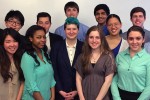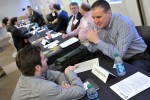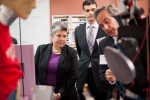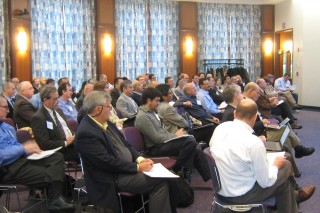News & Events
Event
ALERT Renames the ADSA workshops August 13, 2014

We are pleased to announce the renaming of the ADSA workshops from “Algorithm Development for Security Applications” to “Advanced Development for Security Applications.” This change reflects the fact that the scope of these workshops has expanded well beyond algorithms as the series has progressed.
For example, the following topics for development are now being addressed in these workshops: energy sources (e.g., X-ray, neutrons), sensors (e.g., photon counting X-ray detectors, trace), concept of operations, hardening, deterrence, simulants and testing. The acronym for the workshops, ADSA, will remain the same.
The Eleventh ADSA Workshop (ADSA11) has been scheduled for November 4th and 5th at Northeastern University in Boston, MA. The title of the workshop will be “Explosive Detection in Cargo for Aviation Security – Part II.”
ALERT and Gordon-CenSSIS Hosts the 3rd ASPIRE to promote Student and Industry Networking April 18, 2014
The 3rd ASPIRE (Annual Student Pipeline to Industry Roundtable Event), hosted by ALERT and Gordon-CenSSIS, was held on April 16th, 2014. Soon-to-be-graduating students were given the opportunity to present their research work and career goals to our ALERT and Gordon-CenSSIS Industrial Advisory Board (IAB) members. Six graduate students presented, one from Boston University (an ALERT partner institution), and five from Northeastern University.
Congratulations to our Scholars!!! April 18, 2014

Congratulations to the ALERT and Gordon-CenSSIS Scholars who have completed the 2014 Spring Program! The Scholars program is for freshmen engineering students at Northeastern University, who participate in an ALERT or Gordon-CenSSIS related research project during the spring semester. They also attend Scholar meetings and seminars, and complete 5+ hours of STEM outreach to students K-12 in the Boston-area. On Tuesday, April 8th, the Scholars gave their Final Research presentations to their peers, faculty advisors, graduate students, and mentors. Congratulations to our Scholars!!!
Fall 2013 ASPIRE – Nov. 19th November 8, 2013

The Fall 2013 ASPIRE (Annual Student Pipeline Industry Roundtable Event) will be held on Tuesday, November 19th at Northeastern University in the Ballroom in the Curry Student Center. ASPIRE is hosted by The Bernard M. Gordon Center for Subsurface Sensing and Imaging Systems (Gordon-CenSSIS) and the ALERT(Awareness and Localization of Explosives-Related Threats) Center of Excellence. ASPIRE provides an optimum setting for dialog among members of the academic, industrial and government communities and is intended to provide networking opportunities for ALERT and Gordon-CenSSIS students looking for internships, co-op opportunities and full-time jobs.
THIS EVENT REQUIRES REGISTRATION.
If you are interested in attending or would like further information about ASPIRE or Gordon-CenSSIS, please email Melanie Smith.
The topic for this November’s event will be “Graduating STEM Students or the Lack Thereof.” In the coming decade, many Baby Boomers will retire leaving industry scrambling to replace technical expertise in the US workforce. We would like to discuss this crisis and jointly consider possible solutions.
Three Panel Discussions
With this in mind, we will host three panel discussions led by faculty moderators to obtain the perspectives of the following key stakeholder groups:
- Industry
- Graduate Students
- K-14 Pre-College Community
Industrial Members Posters
Following the panel discussions, our ALERT Industrial members will be presenting posters during a networking session focused on their upcoming human resource needs, future product or company development plans and exciting employment opportunities within their companies.
Key topics for discussion will include:
Why are large numbers of Americans not continuing their quest for higher education in STEM fields?
– Cost of education?
– Career Earnings & Compensation packages?
– Competing professions where compensation/reward vs education level is more attractive?
What issues do International students face during their education and upon graduation that make it difficult to use their degrees in the US?
What are the needs of our member companies in terms of workforce development and what educational or recruitment efforts can help with these needs?
How can Industry and Academia work together to attract talented students into STEM fields and provide them with viable career opportunities?
August 1st at 1pm EDT – Technologies for Bomb Response Twitter Chat August 1, 2013

DHS S&T will be hosting a twitter chat on Technologies for Bomb Response today at 1pm EDT. Those of you that are interested can follow the conversation at https://twitter.com/dhsscitech or at #STTechTalk.
The First Responders Group, with support from the Explosives Division and the DHS Office for Bombing Prevention, is hosting a Twitter Chat August 1 from 1:00-2:00 pm EDT. The topic is Technologies for Bomb Response, and the discussion will feature the Semi-Autonomous Pipe Bomb End-Cap Remover (SAPBER), FiRST App (a smart phone application for bomb response), and more!
A Twitter Chat is a virtual, two-way conversation that allows us to reach out to targeted audiences, ask for their feedback on S&T products/services, and answer their questions. We encourage our Twitter followers to tweet (message) us during the Chat so we can provide real-time responses. Twitter users can follow the full conversation using our hashtag (#STTechTalk), a designated word that links tweets from S&T and from participants.
Read MoreConnections are made at ASPIRE March 28, 2013

The ALERT COE and its predecessor, the Bernard M. Gordon Center for Subsurface Sensing and Imaging Systems has had a thirteen year history of close collaboration with our industrial partners. To continue this tradition, we have instituted a new annual event, the Annual Student Pipeline Industry Roundtable Event otherwise known as ASPIRE.
ASPIRE’s goal is to have our industrial partners introduce their companies, their products, and their future needs to one another, to our faculty, and to our student population. Held on March 19, 2013, ASPIRE started with 10-minute presentations by our industrial members, followed by short 2-minute presentations by students. It culminated in a two-hour networking session, consisting of twelve 10 minute “roundtable” discussion slots that companies and students selected as part of the registration process.
The initial feedback from both the industry and our student population has been extremely positive. Four of our small company members have scheduled follow-on meetings with our large member companies, such as Analogic, Raytheon and Siemens. Siemens Corporate Research is also interviewing ALERT graduate students for five new positions. Many of our participants have requested that ASPIRE be held semiannually.
Through such events, ALERT hopes to create closer collaboration amongst our industrial base, while finding the “right” match for our students and partner institutions. We expect that such alliances will respond with agility to future market opportunities as well as government BAAs and RFPs, thereby fostering effective technology transfer.
[photo credit: Craig Bailey/Perspective Photo]
ADSA09 – Call for Speakers February 4, 2013

ALERT is actively looking for speakers for the ADSA09 – Ninth Workshop for Algorithm Development for Security Applications: New Signatures for Explosive Detection for Aviation Security. This event will take place on May 7-8, 2013 at Northeastern University’s campus in Boston, MA.
Read More
ALERT welcomes United States Secretary of Homeland Security, Janet Napolitano November 19, 2012

Awareness and Localization of Explosives-Related Threats was pleased to host U.S. Secretary of Homeland Security, Janet Napolitano on Monday, November 12th following her keynote address at Northeastern University’s Veteran’s Day Ceremony.
To kick off the visit, ALERT’s Director, Professor Michael B. Silevitch, provided Secretary Napolitano with an overview of the ALERT Center of Excellence. Prof. Silevitch then introduced undergraduate and graduate students involved with ALERT research and gave a summary of the demonstrations in video analytics and advanced imaging technologies that were prepared for her briefing. Michael described Napolitano’s visit as a significant opportunity for ALERT and its homeland security research, saying,
“It was very important to get validation from Secretary Napolitano about the relevance of our research and its transition to the field in the areas of video tracking of threats and passenger screening. This acknowledgement inspires us.”
Professor Octavia Camps led the first demonstration featuring ALERT’s Engage to Excel (E2E) Video Analytic Surveillance Transition project, VAST. VAST is a program developed in partnership with Siemens and the Cleveland Transportation Security Administration. The live demonstration exhibited the video analytic counter-flow program developed by Dr. Camps and her team and its ability to automatically detect when a person is proceeding the wrong way in an identified traffic pattern (for example, trying to enter through an exit). The resulting detections enable quick identification of an incident and minimize the impact on TSA resources. This project is currently installed within the Cleveland Hopkins International Airport.
Following the video analytics demonstration, Professor Carey Rappaport showed Secretary Napolitano the capabilities of the ALERT Advanced Imaging Technologies (AIT) laboratory. This laboratory fuses together various scanning tools to create next-generation security scanning systems. Professor Rappaport, Assistant Professor Jose Martinez and graduate student Spiros Mantzavinos demonstrated the operation and data acquisition capabilities of ALERT’s advanced portal-based millimeter-wave imaging radar. During the demo, the system scanned a mannequin wrapped in a skin simulant with various representative objects attached for detection. These types of AIT systems can be used to detect illicit items that passengers may be attempting to carry on their person.
“As a DHS-supported researcher, I found Secretary Napolitano’s visit very satisfying,” Prof. Rappaport commented. “She was of course quite knowledgeable about the science and technology we are pursuing, but she seemed keenly interested in how we were improving the state of the art. She was completely supportive and she motivated the students with her passion to keeping Americans safe.”
Spiros Mantzavinos, currently a Northeastern University Doctoral Candidate in Electrical and Computer Engineering and Gordon Engineering Leadership Fellow, had the opportunity to meet Secretary Napolitano. Mantzavinos said, “It was an honor to host Secretary Napolitano for a visit to our ALERT whole-body imaging lab. Receiving attention and recognition from such a prominent figure in the national security arena assures the relevance of the advances we are making.”
Associate Director presents at the first DHS Science and Technology(S&T) Research Council Webinar October 25, 2012

ALERT Associate Director, Carey Rappaport was invited to speak at the first DHS Science and Technology(S&T) Research Council Webinar on Monday, October 22nd. Prof. Rappaport participated in the Explosives Detection Panel, which discussed the Quadrennial Homeland Security Review mission flow down to potential technology solutions supported by S&T with subject matter experts (SMEs) from DHS labs, DOE National Labs, and S&T Centers of Excellence.
In addition to Prof. Rappaport, the panel also included:
Jon L. Maienschein, Ph.D.
Director, National Explosives Engineering Sciences Security Center
Director, LLNL Energetic Materials Center
Leader, PLS Energetic Materials Group
Physical and Life Sciences Directorate
Lawrence Livermore National Laboratory
Richard T. Lareau, Ph.D., Chief Scientist,
U.S. Dept. of Homeland Security
Science and Technology Directorate
Transportation Security Laboratory
David Atkinson, Ph.D., Chief Scientist
Explosives Detection Research
Pacific Northwest National Laboratory
An Introduction to the Research and Industrial Collaboration Conference (RICC) October 3, 2012
For more than a decade, the RICC has fostered in-depth dialog among members of the academic, industrial and government communities interested in collaboration in subsurface sensing and imaging and homeland security related topics. This video, taken at the 2011 RICC, provides an overview of the successful event from the perspective of its participants.

